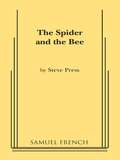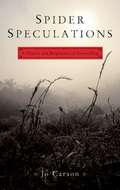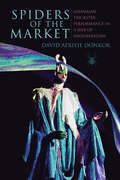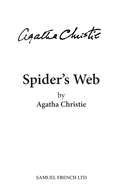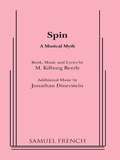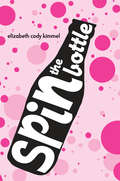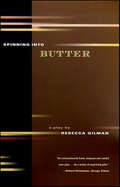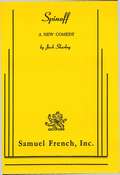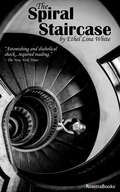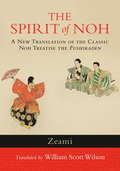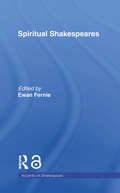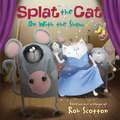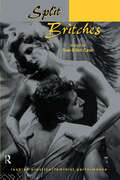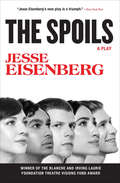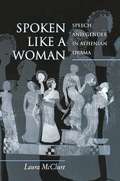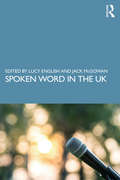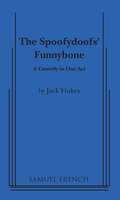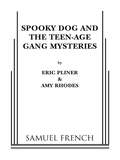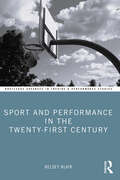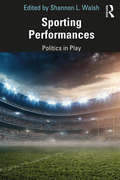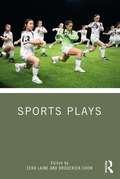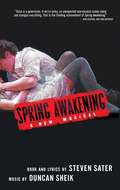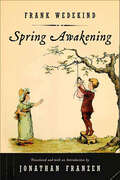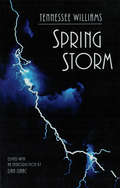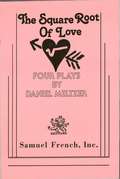- Table View
- List View
Spider and the Bee
by Stephen PressPlay \ 5 m. & f. \ Bare stage. \ This delightful play for a wide age group is based on Jonathan Swift's story "Battle of the Books". It won the National Children's Theatre Playwrighting Competition, and has had many successful productions nationwide. The story is about a "battle" between a spider, who believes "we were born to think and the sciences and math are what make us think," and a bee, who has "soared toward the sun, sung with the meadowlark and heard the thousand tongues of man and insects.'. The bee believes only in the glory, and power, of poetry. Other characters include a Termite, a Butterfly and a Ladybug. A "trial" is held, during which the spider and the bee argue their points of view-- and the other characters must decide who is the "winner" of this debate. The play is loaded with broad humor and fun, as well as food for thought.
Spider Speculations
by Jo Carson"I've spent about 15 years plus some working with people's stories in a series of communities in this country. I write plays from oral histories for those communities. Just finished my 30th. I'm watching people's lives and communities literally change, sometimes drastically, for the work. Spider Speculations is the beginning of trying to understand the hows and whys of all the changes."--Author Jo CarsonJo Carson lays bare her personal investigation into her own creative process after a spider bite on her back begins a series of life-altering events. Spider Speculations applies cutting edge mind-body science, quantum physics and ancient shamanistic techniques to describe how stories work in our bodies and our lives, and what happens when real stories are used in a public way. Carson, whose ability to capture the spoken word hallmarks her community-based work, sets down this story in her own distinctive voice, interspersing the journey with examples of her performance work. This truly original American book will speak to anyone thinking about art and community or engaging with people's stories.Jo Carson is a writer and performer living in John City, Tennessee. She has published award-winning plays, short stories, children's books, essays, poems and other work. Her play Whispering to Horses and solo show If God Came Down...premiered at Seven Stages in Atlanta. She currently performs Liars, Thieves, and Other Sinners on the Bench, made up of selected stories from her oral history plays, which will be published by TCG in 2007.
Spiders of the Market: Ghanaian Trickster Performance in a Web of Neoliberalism (African Expressive Cultures)
by David Afriyie DonkorAn analysis of the trickster spider character from West African folklore, performance, and Ghanian politics.The Ghanaian trickster-spider, Ananse, is a deceptive figure full of comic delight who blurs the lines of class, politics, and morality. David Afriyie Donkor identifies social performance as a way to understand trickster behavior within the shifting process of political legitimization in Ghana, revealing stories that exploit the social ideologies of economic neoliberalism and political democratization. At the level of policy, neither ideology was completely successful, but Donkor shows how the Ghanaian government was crafty in selling the ideas to the people, adapting trickster-rooted performance techniques to reinterpret citizenship and the common good. Trickster performers rebelled against this takeover of their art and sought new ways to out trick the tricksters.“A precise and inviting appeal to political economy, performance, and the enduring relevance of the cultural and archetypal trickster.” —D. Soyini Madison, Northwestern University“David Afriyie Donkor’s experience as a theatre artist and director supports the rich political economic component that frames this analysis of performance and performance traditions for broad audiences.” —Jesse Weaver Shipley, Haverford College“By sharing the performance experiences, rather than texts, Donkor accomplishes the challenging task of introducing rare theatre performances in a particularly compelling context for a Western readership in a global age.” —Theatre Survey“Overall, as a Ghanaian actor and director as well as a scholar, Donkor’s cultural insider analyses of ananse theatre within the space of political economy make important contributions and interventions to the discourses on performance (theory) and neoliberalism and their interaction in Ghana and Africa.” —African Studies Review
Spider's Web
by Agatha ChristieFull Length Play / Mystery Thriller / 8m, 3f / Interior Set. Clarissa, the second wife of Henry Hailsham Brown, is adept at spinning tales of adventure for their bored diplomatic circle. When a murder takes place in her drawing room she finds live drama much harder to cope with, especially as she suspects the murderer might be her young stepdaughter Pippa. Worse still, the victim is the man who broke up Henry's first marriage. Moreover Henry will be arriving shortly with a V.I.P. who might take a dim view of bodies in the drawing room. Clarissa's fast talking places her and Pippa in some hair raising experiences. By the time Henry arrives, the murderer has been unmasked and all is normal so normal that Henry is unable to believe Clarissa when she explains why there are no refreshments for their honored guest.
Spin: A Musical Myth
by Jonathan Dinerstein M. KilburgMusical \ 3 m, 6 f. \ Unit set with phases. \ Inspired by the classical myth about a girl whose brilliant weaving rivals that of the gods, this exciting musical is set in ancient Greece but employs modern language and imagery. A headstrong teen determined to achieve success and fame as an artist is encouraged by four of the Muses, cleverly portrayed as a girl singing group, to leave her village for the city. In Athens she is challenged to compete by the jealous goddess Athena. The resulting showdown of mythic proportions forever changes her view of the world and her creative life. The tuneful pop-rock score has gospel, doo-wop, blues and more. Original and smart, Spin is ideal for schools and community theatres looking for a charming, off-the-beaten-track musical that is perfect for all audiences and suitable for multiracial and ethnic casting.
Spin The Bottle
by Elizabeth Cody KimmelMiddle school is an Entirely New Planet. The girls look fully grown in the most glamorous and complicated ways, and the boys look... well, weird. The good news? Drama Club. Real Drama Club -- with actual auditions, and roles involving more than the days of the week. Phoebe Hart has waited a long time for this. The stage, after all, is the one place the "flawed and unremarkable" Phoebe can let her inner star out. But when she learns of the opening night tradition?a game of Spin the Bottle?things suddenly get way more complicated. Enter: a heart-stopping crush, a best friend who might not be, two bloodthirsty Drama Divas, and a certain spinning bottle. Is it worth all the drama for a girl who just wants to fit in, and maybe prove her acting chops along the way? Welcome to middle school, Phoebe Hart....
Spinning into Butter: A Play
by Rebecca GilmanSet on a college campus in Vermont, Spinning into Butter is a new play by a major young American playwright that explores the dangers of both racism and political correctness in America today in a manner that is at once profound, disturbing, darkly comic, and deeply cathartic. Rebecca Gilman challenges our preconceptions about race relations, writing of a liberal dean of students named Sarah Daniels who investigates the pinning of anonymous, clearly racist letters on the door of one of the college's few African American students. The stunning discovery that there is a virulent racist on campus forces Sarah, along with other faculty members and students, to explore her feelings about racism, leading to surprising discoveries and painful insights that will rivet and provoke the reader as perhaps no play since David Mamet's Oleanna has done.Spinning into Butter had its world premiere at the Goodman Theatre in Chicago in May 1999 and opened at the Vivian Beaumont Theater at Lincoln Center in New York in April 2000.
Spinoff
by Jack SharkeyComedy / 3m, 3f / Interior / Peter Colton, a bank official, unwittingly comes home with the loot from a bank robbery masterminded by Willy Nicholas, his superior at the bank. Willy, frantic to retrieve the money, enlists Peter's services to help him find it, with the help of Victoria Wickey, Peter's secretary. Meantime, Laurel Colton, Peter's daughter, has found the loot and erroneously supposes it is her father who has robbed the bank, so she enlists the aid of her boy friend Carlos Ortega, whose uncle is a retired forger of passports, to help her father flee the country. But the arrival of Sheila Mahoney, a travel agent who is helping Peter plan a surprise vacation to Rio for Laurel, complicates matters even further, since thanks to another plot afoot she thinks Victoria is married to Willy and planning a honeymoon in Rio for the two of them. By the time Victoria shows up with Peter's and Laurel's passports for the surprise vacation, Willy shows up with his and Victoria's passports for a quick escape, and Carlos shows up with a pair of forged passports to help Laurel and Peter escape, everybody is in an ungodly mess, the police may close in any minute, all concerned are fearfully mistaken about everyone else's motives and loyalties, and doom and shame and prison stare them all in the face.
The Spiral Staircase
by Ethel White"Adept at laying one icy finger on the back of your neck" - SpectatorHelen Capel is hired as a live-in lady-help to the Warren family in the countryside. She enjoys the eccentric household and her duties, but her peaceful and simple life is soon disturbed by a series of mysterious murders in the isolated community.As Helen's employer, Professor Sebastian Warren, battens down the hatches and locks all the doors of their remote country house, the eight residents begin to feel safe. But somewhere out there lurks a murderer of young girls. As the murders crawl closer to home, Helen starts to wonder if there really is safety in numbers--and what happens when those numbers start to dwindle?
The Spirit of Noh: A New Translation of the Classic Noh Treatise the Fushikaden
by William Scott Wilson ZeamiThe Japanese dramatic art of Noh has a rich six-hundred-year history and has had a huge influence on Japanese culture and such Western artists as Ezra Pound and The Japanese dramatic art of Noh has long held a fascination for people both in the East and the West. For six hundred years it has had a huge influence on Japanese culture--and has inspired such Western artists as Ezra Pound and William Butler Yeats. Here is a translation of the Fushikaden, a seminal treatise on Noh by the fifteenth-century actor and playwright Zeami (1363-1443), the most celebrated figure in the art's history. His writings on Noh were originally secret teachings that were later coveted among the highest ranks of the samurai class and first became available to the general public only in the twentieth century. The Fushikaden is the best known of Zeami's writings on Noh and it provides practical instruction for actors, gives valuable teachings on the aesthetics and spiritual culture of Japan, and offers a philosophical outlook on life. Along with the Fushikaden, translator William Scott Wilson includes a comprehensive introduction describing the intriguing history behind this enigmatic and influential art form, and also a new translation of one of Zeami's most moving plays, Atsumori.
Spiritual Shakespeares (Accents on Shakespeare)
by Ewan FernieSpiritual Shakespeares is the first book to explore the scope for reading Shakespeare spiritually in the light of contemporary theory and current world events. Ewan Fernie has brought together an exciting cast of critics in order to respond to the ‘religious turn’ in recent literary theory and to the spiritualized politics of terrorism and the ‘War on Terror’. Exploring a genuinely new perspective within Shakespeare Studies, the volume suggests that experiencing the spiritual intensities of the plays could lead us back to dramatic intensity as such. It tests spirituality from a political perspective, as well as subjecting politics to an unusual spiritual critique. Amongst its controversial and provocative arguments is the idea that a consideration of spirituality might point the way forward for materialist criticism. Reaching across and beyond literary studies to offer challenging and powerful contributions from leading scholars, this book offers unique readings of some very familiar plays.
Splat the Cat: On with the Show (Splat the Cat)
by Rob ScottonSplat the Cat can't wait to be in his school play about castles and kings and queens—maybe he'll even get to play a knight! Will Splat find a way to steal the show? Join him and his classmates for another hilarious Splat the Cat adventure!
Split Britches: Lesbian Practice/Feminist Performance
by Sue-Ellen CaseThe Split Britches theatre company have led the way in innovative and challenging lesbian performance for the last decade. Split Britches: Lesbian Practice/Feminist Performance is a long awaited celebration of the theatre and writing of Lois Weaver, Peggy Shaw and Deborah Margolin, who make up this outstanding troupe. This unique anthology comes complete with: * seven of Split Britches' best loved performance texts * a critical, historical introduction by Sue-Ellen Case * programme notes to accompany each of the plays * a range of stunning photographic illustrations The publication of the Split Britches play texts, collected here for the first time, provides invaluable access to these celebrated performance pieces for both the student and contemporary arts audience.
The Spoils: A Play (Books That Changed the World)
by Jesse EisenbergA powerful play about wealth, narcissism, and entitlement: “Eisenberg writes funny, but he is also a real storyteller—moody and dangerous and even loving.”—NewsdayNobody likes Ben. Ben doesn’t even like Ben. He’s been kicked out of grad school, lives off his parents’ money, and bullies everyone in his life, including his roommate, an earnest Nepalese immigrant. When Ben discovers that his grade school crush is marrying a straitlaced banker, he sets out to destroy their relationship and win her back. The Spoils is a deeply personal and probing comedy written by Jesse Eisenberg—Academy Award-nominated actor, playwright, and contributor to the New Yorker. “While Ben would surely say The Spoils is all about Ben, Mr. Eisenberg has seen fit to surround his leading narcissist with characters who live and breathe and react independently…His clever, frantic dialogue assumes an irresistible authenticity.”—Ben Brantley, The New York Times (NYT Critics’ Pick)
Spoken Like a Woman: Speech and Gender in Athenian Drama
by Laura McClureIn ancient Athens, where freedom of speech derived from the power of male citizenship, women's voices were seldom heard in public. Female speech was more often represented in theatrical productions through women characters written and enacted by men. In Spoken Like a Woman, the first book-length study of women's speech in classical drama, Laura McClure explores the discursive practices attributed to women of fifth-century b.c. Greece and to what extent these representations reflected a larger reality. Examining tragedies and comedies by a variety of authors, she illustrates how the dramatic poets exploited speech conventions among both women and men to construct characters and to convey urgent social and political issues.From gossip to seductive persuasion, women's verbal strategies in the theater potentially subverted social and political hierarchy, McClure argues, whether the women characters were overtly or covertly duplicitous, in pursuit of adultery, or imitating male orators. Such characterization helped justify the regulation of women's speech in the democratic polis. The fact that women's verbal strategies were also used to portray male transvestites and manipulators, however, suggests that a greater threat of subversion lay among the spectators' own ranks, among men of uncertain birth and unscrupulous intent, such as demagogues skilled in the art of persuasion. Traditionally viewed as outsiders with ambiguous loyalties, deceitful and tireless in their pursuit of eros, women provided the dramatic poets with a vehicle for illustrating the dangerous consequences of political power placed in the wrong hands.
Spoken Word in the UK
by Lucy EnglishSpoken Word in the UK is a comprehensive and in-depth introduction to spoken word performance in the UK – its origins and development, its performers and audiences, and the vast array of different styles and characteristics that make it unique. Drawing together a wide range of authors including scholars, critics, and practitioners, each chapter gives a new perspective on performance poetics. The six sections of the book cover the essential elements of understanding the form and discuss how this key aspect of contemporary performance can be analysed stylistically, how its development fits into the context of performance in the UK, the ways in which its performers reach and engage with their audiences, and its place in the education system. Each chapter is a case study of one key aspect, example, or context of spoken word performance, combining to make the most wide-ranging account of this form of performance currently available. This is a crucial and ground-breaking companion for those studying or teaching spoken word performance, as well as scholars and researchers across the fields of theatre and performance studies, literary studies, and cultural studies.
Spoofydoof's Funnybone
by Jack FrakesComedy / 7m, 9f / The spoofydoofs live peacefully under a tree-- their only worry is the Hurry Scurries. Gigles finds a funnybone that makes everyone laugh. His search party is chased by Polly and her dog-- and by gloomy faced Aunt Nettie, a Hurry Scurry. The spoofydoofs catch her and hand her the funnybone. She happily returns to Hurry Scurry land to spread laughter.
Spooky Dog & The Teen-Age Gang Mysteries
by Eric PlinerSpooky Dog & the Teen-Age Gang Mysteries is an irreverent parody of Saturday morning cartoons - for adults only. Missing from a starring performance at a creepy county fair, a pop culture icon (suggested by the audience) can only be located by this familiar gang of teen sleuths: a butch, blond frat boy, an even more butch brainy gal with a trusty flashlight, a hot-to-trot diva in a miniskirt, a spaced-out hippie, and a talking dog. On a campy and comical quest to find their missing friend, they'll face the ghost of a dead country singer, a not-so-psychic fortune teller, and the sinister couple who run the fairground - and that's not all. Even more frighteningly, the Teen-Age Mystery Gang will also confront their own burgeoning sexual desires, tasty dog treats with unexpected side effects, and a surprise penchant for busting a move. Spooky Dog uncovers hilarious, hidden subtext with razor-sharp wit and affectionate homage. You'll never see Saturday morning the same way again!
Sport and Performance in the Twenty-First Century (Routledge Advances in Theatre & Performance Studies)
by Kelsey BlairAnalyzing sport through the lens of performance and theorizing performance through the lens of sport, Sport and Performance in the Twenty-First Century offers a field intervention, a series of in-depth performance analyses, and an investigation of the intersection between sport performances and public life in the historical present in the global north. The objectives of this book are three-fold. First, the book advocates for the study of sport in the fields of Theatre and Performance Studies and, through in-depth performance analyses, demonstrates how the critical language and methods of performance studies help illuminate the manifold impacts of the practices, activities, and events of sport. Second, the book introduces new critical language that was originally developed in conjunction with sport but is also designed for cross-genre performance analysis. In introducing novel terminology, the book aims to simultaneously facilitate analysis of sport performances and to demonstrate how the study of sport can contribute to the fields of Theatre and Performance Studies. Finally, the book investigates the epistemological, affective, and socio-political effects of sport performances in order to illuminate how sport performances influence, and are influenced by, their historical conditions. This study will be of great interest to students and scholars in Theatre and Performance Studies, Physical Culture Studies, and Socio-Cultural Sports Studies.
Sporting Performances: Politics in Play
by Shannon L. WalshSporting Performances is the first anthology to tackle sports and physical culture from a performance perspective; it serves as an invitation and provocation for scholarly discourse on the connections between sports and physical culture, and theatre and performance. Through a series of intriguing case studies that blur the lines between the realms of politics, sports, physical culture, and performance, this book assumes that sporting performances, much like theatre, serve as barometers, mirrors, and refractors of the culture in which they are enmeshed. Some of the topics include nineteenth-century variety show pugilists, athletes on Broadway, sumo wrestlers, rhythmic gymnasts, and Strava enthusiasts. While analyzing sport through the lens of theatre and performance, this anthology reflects on how physical culture and sports contribute to identity formation and the effects of nuanced imprints of physical activity on the mind, soul, and tongue. Written primarily for those interested in physical fitness, sports, dance, and physical theatre, this interdisciplinary volume is a crucial tool for Performance and Theatre Studies students and those in the fields of Sports Studies, Cultural Studies, Women’s and Gender Studies, and American Studies more broadly.
Sports Plays
by Sports PlaysSports Plays is a volume about sports in the theatre and what it means to stage sports. The chapters in this volume examine sports plays through a range of critical and theoretical approaches that highlight central concerns and questions both for sports and for theatre. The plays cut across boundaries and genres, from Broadway-style musicals to dramas to experimental and developmental work. The chapters examine and trouble the conventions of staging sports as they open possibilities for considering larger social and cultural issues and debates. This broad range of perspectives make the volume a compelling resource for students and scholars of sport, theatre, and performance studies whose interests span feminism, sexuality, politics, and race.
Spring Awakening
by Steven Sater Duncan Sheik"This brave new musical, haunting and electrifying by turns, restores the mystery, the thrill to that shattering transformation that stirs in all our souls."--Charles Isherwood, The New York Times"The staggering purity of this show will touch all open hearts...In its refined, imaginative simplicity, it daringly reverses all the conventional rules by returning the American musical to an original state of innocence."--John Heilpern, The New York Observer"An unexpected jolt of sudden genius, edgy in its brutally honest, unromanticized depiction of human sexuality."--New York Post Spring Awakening is an extraordinary new rock musical with book and lyrics by Steven Sater and music by Grammy Award-nominated recording artist Duncan Sheik. Inspired by Frank Wedekind's controversial 1891 play about teenage sexuality and society's efforts to control it, the piece seamlessly merges past and present, underscoring the timelessness of adolescent angst and the universality of human passion. Steven Sater's plays include the long-running Carbondale Dreams, Perfect for You, Doll (Rosenthal Prize/Cincinnati Playhouse), Umbrage (Steppenwolf New Play Prize), and a reconceived version of Shakespeare's Tempest, which played in London. Duncan Sheik is a singer/songwriter who also collaborated with Sater on the musical The Nightingale. He has composed original music for The Gold Rooms of Nero and for The Public Theater's Twelfth Night in Central Park.
Spring Awakening: A Play
by Frank WedekindFrom Jonathan Franzen, bestselling author of The Corrections and Crossroads, comes his razor-sharp translation of Frank Wedekind's major modern play, Spring Awakening.Featuring an introduction by Franzen.First performed in Germany in 1906, Frank Wedekind's controversial play Spring Awakening closed after one night in New York in 1917 amid charges of obscenity and public outrage. For the better part of the twentieth century Wedekind's intense body of work was largely unpublished and rarely performed. Yet the play's subject matter—teenage desire, suicide, abortion, and homosexuality—is as explosive and important today as it was a century ago. Spring Awakening follows the lives of three teenagers, Melchior, Moritz, and Wendl, as they navigate their entry into sexual awareness. Unlike so many works that claim to tell the truth of adolescence, Spring Awakening offers no easy answers or redemption.Today, more than a hundred years after the play's first performance, a new musical version of this essential modern masterpiece is being hailed as the "best new musical . . . in a generation" (John Heilpern, The New York Observer). Franzen's rendition of the text—for so long poorly served in English—is unique in capturing the bizarre and inimitable comic spirit that animates almost every line of this unrelentingly tragic play. There couldn't be a better time for this thrilling, definitive new translation.
Spring Storm
by Dan Isaac Tennessee Williams"A crucible of so many elements that would later shape and characterize Williams's work."--World Literature Today When Tennessee Williams read Spring Storm aloud to his playwriting class at the University of Iowa in 1938, he was met with silence and embarrassment. His professor, the renowned E. C. Mabie, remarked as he got up and dismissed the seminar, "Well, we all have to paint our nudes!" Tom's earlier comment in his journal that the play "is well-constructed, no social propaganda, and is suitable for the commercial stage" seems accurate enough in 1999, but woefully naive deep in the Depression when the play's sexual explicitness--particularly its matter-of-fact acceptance of a woman's right to her own sexuality--would have been seen as not only shocking but also politically radical. Spring Storm would later be disavowed by the author as "simply a study of Sex--a blind animal urge or force (like the regenerative force of April) gripping four lives and leading them into a tangle of cruel and ugly relations." But the solid and deft characterizations of the four young people whose lives intertwine--the sexually alive Heavenly Critchfield, her earthy lover Dick Miles, Heavenly's wealthy but tongue-tied admirer Arthur Shannon, and the repressed librarian Hertha Nielson who loves Arthur--are archetypes of characters we will meet again and again in the Williams canon. Epic in scope, a bit melodramatic in execution, tragic in outcome, Spring Storm created a wave of excitement among theatre insiders when it was given a staged reading at The Ensemble Studio Theatre's Octoberfest '96. This edition has been prepared, with an illuminating introduction, by Dan Isaac, who initiated the Octoberfest production.
Square Root of Love (Off-off Broadway Festival Plays Ser.)
by Daniel Meltzer4 Simple Interiors / This full length evening portrays four preludes to love from youth to old age, from innocence to maturity. It is best when played by a single actor and actress. In The Square Root of Love, two genius level college students discover that Man or Woman does not live by intellectual pursuits alone. A Good Time for a Change finds a successful executive and her handsome young male secretary ready to make a change. The Battling Brinkmires are George and Marsha Brinkmire, a middle aged couple who have come to Haiti to get a "quickie" divorce. This one has a surprise ending. In Waiting for to Go, we are on a jet waiting to take off for Florida. He's a retired plumbing contractor who thinks his life is over she's a recent widow returning to her home in Hallandale. The play, and the evening ends with a beginning. This Off Off Broadway success requires only minimal settings.
